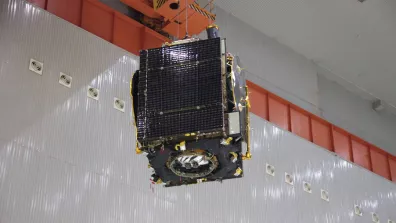CNES has been working with French manufacturers since 1994 to develop new-generation Hall-effect plasma thrusters, a cheap and mature technology that significantly reduces fuel mass required to position satellites in their final orbit.

Key information
| Mission | Create a new generation of satellites relying solely on electric thrusters for positioning and stationkeeping |
|---|---|
| Domain | Cross-cutting |
| Start date | Inception of electric propulsion satellites project in 2015, first orbital flight in June 2017 with Eutelsat 172B |
| Partners | Safran Aircraft Engines, ESA, CNRS, Thales Alenia Space, Airbus Defence & Space |
| Where | Earth orbit |
| Lifetime | Indefinite |
| Status | In operation |
Key figures
- 30% satellite mass saving over chemical propulsion
- 15 to 25 km/s: speed of ions ejected by Hall-effect thrusters
- 1,000 to 8,000 s: specific impulse range of Hall-effect thrusters
- 10 times smaller fuel tank
Key milestones
- 1 June 2017: Launch of Eutelsat 172B, the first satellite to employ Hall-effect thrusters
- 2000: CNES helps Safran to develop Hall-effect thrusters
- 1994: CNES gets involved in development of electric satellites using Hall-effect thrusters
- 1990: Hall-effect plasma thrusters begin to emerge
Project in brief
Since the late 1990s, a new type of propulsion has started to appear in orbit: rather than carrying tanks of heavy and dangerous chemical propellants, plasma thrusters only require a small amount of inert gas—typically xenon—accelerated by the Hall effect using electrical energy from a satellite’s solar panels. Hall-effect thrusters are more efficient and offer the potential to shave several tonnes off the mass of a communications satellite or significantly increase the size of its payload, while dispensing with the operational constraints associated with chemical propellants (handling and corrosion). On the other hand, they generate less thrust.
CNES first became involved with developing electric satellites in 1994 through the French STENTOR project and then the European Alphabus/Alphasat project. Building on this experience, the agency subsequently worked with Safran from the early 2000s to develop a range of thrusters, the PPS 1350 and PPS 5000. Hall-effect thrusters were initially used only to position satellites on their final orbit, but today, thanks to research and development of more powerful thrusters and carefully designed spacecraft buses, it has become possible to conceive ‘all-electric’ satellites that use the technology to reach geostationary orbit and then stay on station for more than a decade of operational service.
CNES’s role
Through the government’s PIA future investment plan, public service subsidies and France’s contribution to ESA’s ARTES programme, CNES is leading the effort to establish these new applications and foster technology spin-off from research to industry. France has gained a leadership position through Safran (propulsion), Airbus Defence & Space and Thales Alenia Space in adapting existing satellite buses (Eurostar 3000EOR) and creating the new-generation Space-busNEO, EurostarNEO, Space Inspire and OneSat.
The first demonstration of an all-electric satellite stemming directly from these programmes was accomplished with the Eutelsat 172B satellite sent aloft from Kourou on 1 June 2017. Equipped with new and powerful Hall-effect thrusters on a Eurostar E3000 bus (Airbus DS), the satellite weighed no more than 3.5 tonnes on launch, a gain of more than 30% over satellites with an equivalent payload, enabling it to be carried in the bottom berth on Ariane 5 and thus generating significant launch cost savings. Eutelsat 172B was positioned in record time, taking only four months to reach orbit, against six to seven months for competing U.S. satellites. It has been operational since mid-November 2017. The first satellite based on the SpacebusNEO platform was launched on 17 January 2020 (Konnect) and the first built around EurostarNEO (Hotbird 13F) on 14 October 2022.
Contacts
PEGASE Project Leader
Christian Dupuy
E-mail christian.dupuy at cnes.fr

